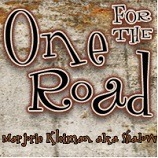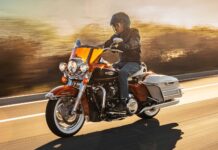 “Hope smiles from the threshold of the year to come, whispering, ‘It will be happier’…” So wrote 19th century poet Alfred Lord Tennyson. And most famous quotes for the new year seem to reflect the same philosophy. But this year, in trying to look optimistically toward the future, I found myself looking backward. I figure, to know where I’m going, it’s helpful to know where I’ve been.
“Hope smiles from the threshold of the year to come, whispering, ‘It will be happier’…” So wrote 19th century poet Alfred Lord Tennyson. And most famous quotes for the new year seem to reflect the same philosophy. But this year, in trying to look optimistically toward the future, I found myself looking backward. I figure, to know where I’m going, it’s helpful to know where I’ve been.
Expanding that perspective into the entire moto culture, it would be an understatement to say that 2017 has been an eventful, impactful year. The industry has gone through some turmoil, such as the cancellation of the V-Twin Expo trade show, and more recently, the Motorsports Aftermarket Group’s announcement of their “debt recapitalization,” which, to put it simply, will be implemented via a Chapter 11 bankruptcy filing. MAG companies include many of our favorite aftermarket parts and accessory purveyors such as J&P Cycles, Biker’s Choice, Mustang, Performance Machine, Ro-land Sands Design, Burly Brand, Kuryakyn, Progressive Suspension, FirstGear, Vance & Hines, and others, some of which have also, in coordination with their parent company, filed for Chapter 11 bankruptcy relief, although company operations will continue uninterrupted.
Motorcycle manufacturers have not gotten away unscathed this year, either. Polaris made the decision to discontinue the Victory motorcycle brand to focus their resources on their Indian and Slingshot brands. Although this action disappointed and, in many cases, angered numerous Victory owners and dealers, the upside for Polaris in 2017 was a 53-percent increase in their stock price and, despite overall motorcycle sales dropping in the U.S., a 10-percent uptick in Indian and Slingshot sales in this country.
Although Harley-Davidson still boasts most of the on-road motorcycle sales in the U.S., their 2017 sales in this country were down about eight percent at the end of the third quarter. The Motor Company took a big chance with the elimination of the Dyna models and the introduction of the re-engineered 2018 Softail line, but I’m certain that the full impact of this massive revamp is yet to be realized. After having ridden several 2018 Softail M-8 models, though, I can tell you that had I waited a year before buying my 2017 Road King, I might have ridden home a 2018 Softail Heritage instead.
The motorcycle event landscape is changing as well. The number of regional bike shows have dwindled, at least where I live, and several major rallies have either folded or gone on hiatus. National show series have reduced the number of tour stops, and there are fewer vendors at the ones that remain. However, several new regional and national rallies, some of which have already shown a lot of promise, marked 2017 as their inaugural year. And we’re seeing more grassroots-type events all over the country, many of which have grown exponentially in just a few years. To me, these gatherings are more welcoming to the regular rider, more personalized, kind of like a big family reunion, and, as they say, less flash and more gas. And the bikes seen at these events are generally homebuilt and ridden hard, either on the street or at the track. No trailer queens!
Flat track racing is another cultural phenomenon that saw 2017 as its breakout year. Hooligan races have continued to gain ground with both racers and spectators. Billy Lane’s Sons of Speed flat track racing productions have captured the imaginations of the racing public. The ever-popular Flat Out Friday has accompanied the Mama Tried show in Milwaukee the past few years, and here in the Northeast, the Appalachian Moto Jam has started winter hill climbs as well as seasonal flat track racing. And those are just a few regional racing events that have sprung up over the past few years.
The revamping and renaming of AMA’s flat track racing series to American Flat Track, concurrent with the renewal of the Harley vs. Indian battles has generated tremendous interest. Although Harley-Davidson owns the drag strip, Indian kicked butt throughout the 2017 AFT series with its purpose-built FTR750, causing fans to demand an on-road model (a race-only version is already available for privateers, but to the tune of $50,000). Harley didn’t fare nearly as well, having used the Street as a base and modifying it for the track. That said, Harley is coming back with a vengeance, having committed a huge wad of cash to better their chances for podium appearances in 2018.
We hear a lot of doom and gloom from industry experts, bemoaning dwindling sales as well as company closings. There’s a lot of blame being tossed around, but some think a more positive approach is needed, and we’re starting to see efforts being made in this direction, such as Robert Pan-dya’s Give A Shift initiative. Robert, as owner of Spokespeople, a PR and creative firm, has extensive experience in the motorcycle world, having represented Indian Motorcycle and other brands for some years, and has kickstarted a conversation to discuss issues and potentially find some solutions for, as he puts it, “a stalling powersports industry.”
Meanwhile, new social constructs are driving trends, e.g., the growing popularity of adventuring, with moto camping expeditions such as the former Gypsy Run, and more recently, Babes Ride Out on both coasts. And community garages in urban areas are becoming more prevalent: Roll It Up in Brooklyn, New York, The Shed in Milwaukee, Wisconsin, Standard Motorcycle Company in Orlando, Florida, See See Motor Coffee Company in Portland, Oregon… all places where moto folks can gather to wrench, teach, maybe grab a coffee or a bite to eat, or just hang out with like-minded moto folks while enjoying the culture we love.
Through all these changes taking place, I still have the same excitement about motorcycles as when I first learned to ride. And despite the naysayers, I’m just as excited to see what the future of motorcycling may bring. What about you?



















